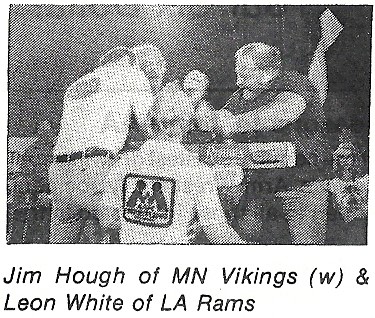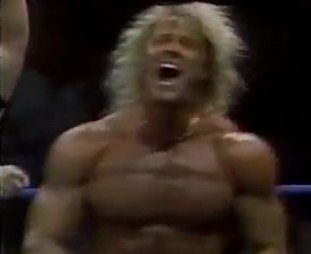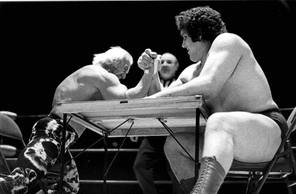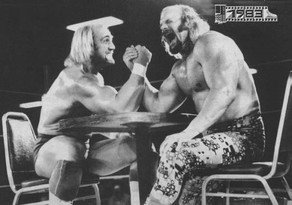Armwrestling Matches in Professional Wrestling
“Gimmick” matches have always had an important place in the world of professional wrestling. As standard wrestling matches can become a bit stale, various types of competitions between wrestlers are used to keep the public’s interest. Wikipedia includes a long list of these types of competitions. Armwrestling matches are seen by many as a good test of strength and have therefore been used throughout the history of professional wrestling as a different way to show who the better man is.
While all armwrestling matches are staged in professional wrestling (i.e. the winner is pre-determined), a few wrestlers actually do/did have a background in organized armwrestling competition. The wrestler with the most successful armwrestling career is Scott Norton, who won the super heavyweight class of the Over the Top World Championship in 1986. (This tournament served as the competition backdrop for the Sylvester Stallone movie “Over the Top”.) Another wrestler, Leon White (“Van Vader”), made it to the later rounds of the AWI NFL Super Classic armwrestling tournament on two occasions in the late ‘70s and early ‘80s, during his brief football career with the Los Angeles Rams. Scott Bigelow ("Bam Bam Bigelow") also briefly tried out the sport and enjoyed considerable success, finishing in an impressive second place at the World Professional Wristwrestling Association (WPWA) Worlds behind only Cleve Dean in 1980. Finally, Richard Rood (“Ravishing Rick Rude") competed in a few armwrestling tournaments in Minnesota in the early '80s and also reportedly finished 6th in an AWI pro light heavyweight world championship in 1983, though this assertion has not been verified.
One of the first major professional wrestling stars to regularly use armwrestling matches to demonstrate his superior strength was Superstar Billy Graham. In 1973, he declared himself “the arm wrestling champion of the universe”. However, he did lose the occasional match, perhaps most famously to André the Giant in 1975.
Aside from being staged, armwrestling matches in professional wrestling differ from armwrestling matches in organized armwrestling tournaments in two significant ways. First, pro wrestling armwrestling matches are always long. Typically they last over one minute in length and feature a lot of back and forth action. Long matches of this type are much less common in actual armwrestling. Second, very few pro wrestling matches are free of controversy. Many don't actually reach a pin -- either one of the wrestlers stops pulling in order to hit the other, or someone else interferes (which could involve any number of things). Of those that do end in a pin, there's almost always an excuse -- there was a distraction, the winner cheated/started early, etc.
Through the '70s and '80s, almost all pro wrestling armwrestling matches were done sitting down. A variety of different tables were used, but they were generally of the folding style, with the competitors seated on folding chairs. Because the tables and chairs often ended up being thrown, they needed to be relatively light. On rare occasions, the tables may have had outlined areas for where the elbows needed to stay, but they never had pin pads.
Armwrestling matches were featured most prominently on televised professional wrestling in 1992 and 1993, when Jesse "The Body" Ventura hosted an invitational "Strongest Arm Tournament" for World Championship Wrestling (WCW) two years in a row. The story goes that Mr. Ventura invited the WCW wrestlers that he considered to have the strongest arms to compete in the tournaments.
The "Strongest Arm" tournaments used a single elimination format, and each had eight competitors. An actual stand-up armwrestling table was used (for most of the event), with hand pegs, pin pads, and elbow cups. This was perhaps the first time such a table was used in a professional wrestling setting. The tournaments were run in November and December of the respective years, with one match occurring each week.
The wrestlers involved in the 1992 tournament were Arn Anderson, Steve Austin, The Barbarian, Van Hammer, Nikita Koloff, Ron Simmons, Big Van Vader, and Vinnie Vegas. Unlike most armwrestling held in pro wrestling, the Strongest Arm tournament used an actual stand-up armwrestling table -- possibly the first time one was used in professional wrestling. The tournament results were as follows:
Round 1:
Ron Simmons defeated Steve Austin
The Barbarian defeated Arn Anderson
Van Hammer defeated Vinnie Vegas
Big Van Vader defeated Nikita Koloff
Semi-Finals:
Ron Simmons defeated The Barbarian
Van Hammer defeated Big Van Vader
Final:
Van Hammer defeated Ron Simmons
In a funny twist, after Van Hammer's tournament victory wrestler Tony Atlas entered the ring, upset that he wasn't even in the tournament. Van Hammer therefore challenged him to a match but because it wasn't sanctioned the match couldn't take place.
Aside from being staged, armwrestling matches in professional wrestling differ from armwrestling matches in organized armwrestling tournaments in two significant ways. First, pro wrestling armwrestling matches are always long. Typically they last over one minute in length and feature a lot of back and forth action. Long matches of this type are much less common in actual armwrestling. Second, very few pro wrestling matches are free of controversy. Many don't actually reach a pin -- either one of the wrestlers stops pulling in order to hit the other, or someone else interferes (which could involve any number of things). Of those that do end in a pin, there's almost always an excuse -- there was a distraction, the winner cheated/started early, etc.
Through the '70s and '80s, almost all pro wrestling armwrestling matches were done sitting down. A variety of different tables were used, but they were generally of the folding style, with the competitors seated on folding chairs. Because the tables and chairs often ended up being thrown, they needed to be relatively light. On rare occasions, the tables may have had outlined areas for where the elbows needed to stay, but they never had pin pads.
Armwrestling matches were featured most prominently on televised professional wrestling in 1992 and 1993, when Jesse "The Body" Ventura hosted an invitational "Strongest Arm Tournament" for World Championship Wrestling (WCW) two years in a row. The story goes that Mr. Ventura invited the WCW wrestlers that he considered to have the strongest arms to compete in the tournaments.
The "Strongest Arm" tournaments used a single elimination format, and each had eight competitors. An actual stand-up armwrestling table was used (for most of the event), with hand pegs, pin pads, and elbow cups. This was perhaps the first time such a table was used in a professional wrestling setting. The tournaments were run in November and December of the respective years, with one match occurring each week.
The wrestlers involved in the 1992 tournament were Arn Anderson, Steve Austin, The Barbarian, Van Hammer, Nikita Koloff, Ron Simmons, Big Van Vader, and Vinnie Vegas. Unlike most armwrestling held in pro wrestling, the Strongest Arm tournament used an actual stand-up armwrestling table -- possibly the first time one was used in professional wrestling. The tournament results were as follows:
Round 1:
Ron Simmons defeated Steve Austin
The Barbarian defeated Arn Anderson
Van Hammer defeated Vinnie Vegas
Big Van Vader defeated Nikita Koloff
Semi-Finals:
Ron Simmons defeated The Barbarian
Van Hammer defeated Big Van Vader
Final:
Van Hammer defeated Ron Simmons
In a funny twist, after Van Hammer's tournament victory wrestler Tony Atlas entered the ring, upset that he wasn't even in the tournament. Van Hammer therefore challenged him to a match but because it wasn't sanctioned the match couldn't take place.
The wrestlers who took part in the 1993 Strongest Arm tournaments were "Stunning" Steve Austin, Awesome Kong, The Equalizer, Van Hammer, Ice Train, Maxx Pain, Sid Vicious, Davey Boy Smith, and Vader. For the first round of matches an actual stand-up armwrestling table was used, but for unknown reasons, for the semi-finals and the final a stand-up, square, boxed table was used. There were no pin or elbow pads. There were hand pegs but at the corners of the table, rather than in the middle. The tournament results were as follows:
Round 1:
The Equalizer defeated Van Hammer
Ice Train defeated "Stunning" Steve Austin
Sid Vicious defeated Maxx Payne
Davey Boy Smith defeated Awesome Kong
Semi-Finals:
Ice Train defeated The Equalizer
Vader defeated Davey Boy Smith
Final: Vader defeated Ice Train
Vader was not originally involved in the 1993 tournament, but was brought in for the semi-finals because a replacement was required for Sid Vicious. Though never explained on air, Sid had recently been involved in a serious real-life scuffle with wrestler Arn Anderson, and many WCW wrestlers threatened to leave the organization because of him. WCW ended up having to release Sid from his contract.
After the two annual Strongest Arm tournaments, armwrestling matches once again became relatively rare occurrences in pro wrestling. Since then, when there have been matches, they've typically been decided on stand-up tables.
Mini armwrestling contests have also been featured in recent years as challenges in WWE's NXT and Tough Enough "reality" series where rookies compete to be the next big wrestling star. Such contests were featured in seasons 2 and 4 of Tough Enough, and seasons 3, 4, and 5 of NXT. The purpose was of these challenges was not so much to determine who the best armwrestlers were, but rather to see how the crowd reacted to the different wrestlers. The challenge winners were as follows:
Tough Enough Season 2 (2002) – Jake (2 man contest) and Linda (2 woman contest)
Tough Enough Season 4 (2004) – Daniel Puder (4 man contest)
NXT Season 3 (2010) – Kaitlyn (4 woman contest)
NXT Season 4 (2011) – Johnny Curtis (4 man contest)
NXT Season 5 (2011) – Titus O’Neil (8 man contest)
It appears that staged armwrestling matches will continue to play a very small, but nonetheless entertaining role in the world of professional wrestling. Below are some pictures and clips of classic armwrestling matches in pro wrestling history.
Round 1:
The Equalizer defeated Van Hammer
Ice Train defeated "Stunning" Steve Austin
Sid Vicious defeated Maxx Payne
Davey Boy Smith defeated Awesome Kong
Semi-Finals:
Ice Train defeated The Equalizer
Vader defeated Davey Boy Smith
Final: Vader defeated Ice Train
Vader was not originally involved in the 1993 tournament, but was brought in for the semi-finals because a replacement was required for Sid Vicious. Though never explained on air, Sid had recently been involved in a serious real-life scuffle with wrestler Arn Anderson, and many WCW wrestlers threatened to leave the organization because of him. WCW ended up having to release Sid from his contract.
After the two annual Strongest Arm tournaments, armwrestling matches once again became relatively rare occurrences in pro wrestling. Since then, when there have been matches, they've typically been decided on stand-up tables.
Mini armwrestling contests have also been featured in recent years as challenges in WWE's NXT and Tough Enough "reality" series where rookies compete to be the next big wrestling star. Such contests were featured in seasons 2 and 4 of Tough Enough, and seasons 3, 4, and 5 of NXT. The purpose was of these challenges was not so much to determine who the best armwrestlers were, but rather to see how the crowd reacted to the different wrestlers. The challenge winners were as follows:
Tough Enough Season 2 (2002) – Jake (2 man contest) and Linda (2 woman contest)
Tough Enough Season 4 (2004) – Daniel Puder (4 man contest)
NXT Season 3 (2010) – Kaitlyn (4 woman contest)
NXT Season 4 (2011) – Johnny Curtis (4 man contest)
NXT Season 5 (2011) – Titus O’Neil (8 man contest)
It appears that staged armwrestling matches will continue to play a very small, but nonetheless entertaining role in the world of professional wrestling. Below are some pictures and clips of classic armwrestling matches in pro wrestling history.
1978 match between André the Giant and Terry Boulder (Hulk Hogan). André won because Terry was disqualified.
Below is a series of three matches between Ric Flair and Bad Leroy Brown, circa 1981-82. The NatureBoy just doesn't know when to give up!
Below is a series of three matches between Ric Flair and Bad Leroy Brown, circa 1981-82. The NatureBoy just doesn't know when to give up!
Researched and Written by Eric Roussin
Special thanks to Jeff Dabe for supplying information about Scott Norton and Rick Rude's early days in the sport.
Special thanks to Jeff Dabe for supplying information about Scott Norton and Rick Rude's early days in the sport.








